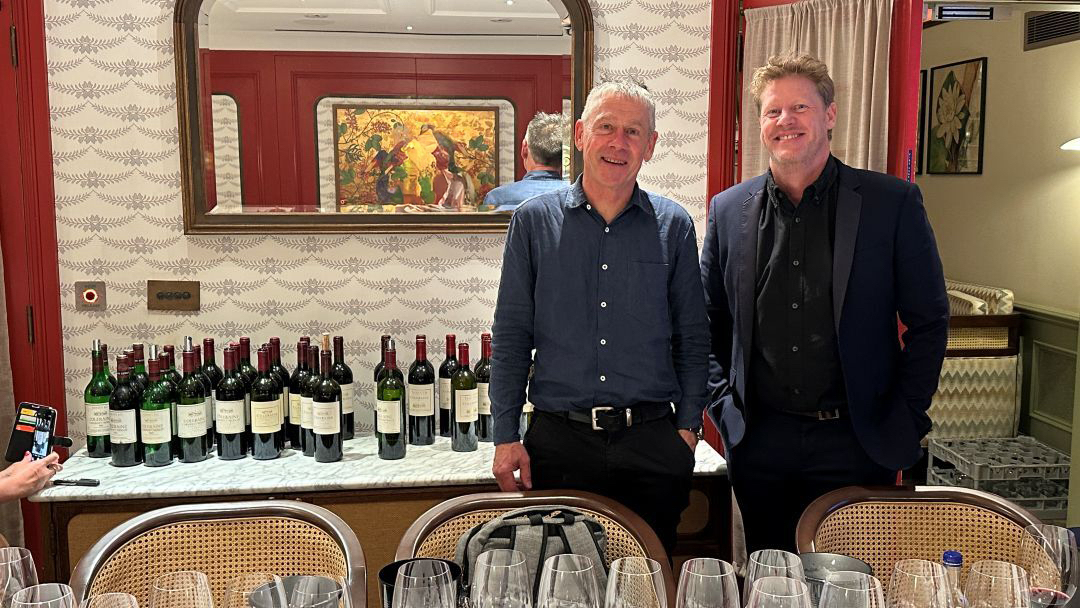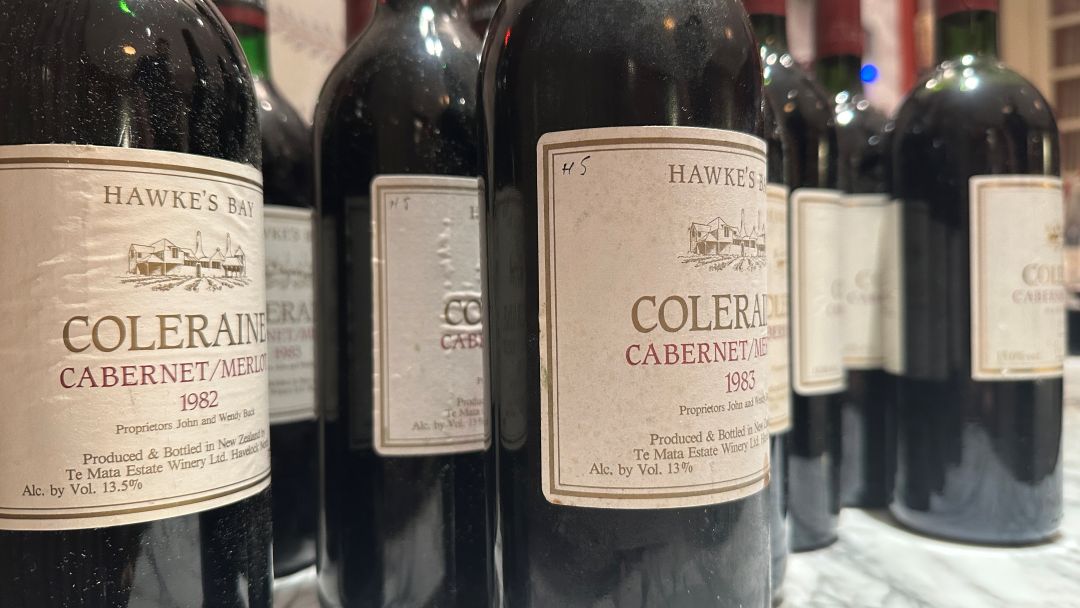Browse using the new Vinous website now. Launch →
Printed by, and for the sole use of . All rights reserved © 2015 Vinous Media
Te Mata Coleraine: 1982-2023
BY NEAL MARTIN | NOVEMBER 26, 2025
Allow me to step on my colleague Rebecca Gibb MW’s turf for one moment. Perusing a merchant’s list a few months ago, a particular wine caught my eye: the 1982 Coleraine from Te Mata Estate. Aside from being born during the primordial period of New Zealand’s wine industry, this wine has historical significance: it was the maiden release of this flagship Bordeaux blend.
I snapped it up. It was not particularly expensive, certainly less expensive than its 1982 contemporaries from elsewhere in the world. Having kept in touch with the Buck family since I handed over coverage, I contacted Toby Buck, curious to see if many bottles were extant in their own library. To cut a long story short, the exchange led to a vertical tasting through Te Mata’s U.K. importer (J.E Fells & Co), which took place in September of this year during Buck’s visit to London with winemaker Phil Brodie.
Te Mata’s history stretches back to the mid-nineteenth century, “Te Mata Station” having been established by English immigrant John Chambers in 1854. Three parcels of vines were planted towards the end of the century. Under Bernard Chambers, the estate expanded viticulture so that by 1909, it had become the country’s largest producer. Whereas most of the grape production was used to make fortified wines, Te Mata vinified a small amount of dry wine. It only just managed to survive New Zealand’s temperance movement, and in 1974, the estate was acquired by the present co-owners, the Buck and Morris families.

Winemaker Nick Brodie (left) and Proprietor Toby Buck (right) of Te Mata Estate.
“From 1982 to 1988, the Coleraine came from a single vineyard planted in 1900 in the Havelock Hills,” Buck explained. It had been over a decade since we had last met. “The varieties were based on Château Latour, although the first vintage did not contain any Cabernet Franc.”
I wondered about the origins of the name.
“Coleraine is the river port in County Derry, Northern Ireland, where my great-grandfather on my dad’s side of the family, Samuel Morrow, came from,” said Buck. The etymology is cuil raithin, which means “nook of fern.” “The Morrows had a hardware business in Coleraine, but in 1908, at just 20 years old, Samuel emigrated to New Zealand. He settled on the East Coast just above Hawke's Bay, selling hardware to rural communities. Family stories suggest his departure was sudden—more of a ‘get on the next boat’ escape than a planned migration. Because he could never return to Europe, the name Coleraine stayed with our family in New Zealand as a mark of our origin—a distant but tough place. To us, it was a reminder of a wider world and a grand remembrance of life, family, community and conviviality. When the vineyard at Te Mata Estate was established, dad chose to name it Coleraine as a tribute to Samuel Morrow and the family story. It was also a way of putting this epic-sounding, evocative moniker, one that he had grown up with, out there in the public eye—in a sense, conjuring it back into reality. To him, it was this beautiful lyrical name to stand proudly among other grand names.”
Phil Brodie explained the origins of the vineyard.
“From 1982 to 1988, the Coleraine came from a single vineyard planted in 1900 and originally called The Hill. In 1989, it became a blend of pickings in order to represent the best of the vintage. From 1994 onward, Coleraine is still based on the Havelock Hills with some fruit coming from the other subregion of Bridge Pa Triangle, and occasionally a sprinkling from the Dartmoor and Gimblett Gravels subregions. It follows the idea that a wine is greater than the sum of its parts, exploiting differences in soil, orientation and so forth. Te Mata Estate owns all vineyards, and we use our own bottling line, so we have full control.”
“I have been making the wine at Te Mata for 33 years,” Brodie continued. “I grew up on a sheep farm, so I was always outside, always walking vineyards. We changed the viticulture in 2019 when we began using cover crops and mulching to lower soil temperatures in the vineyard. We also began to mechanically shake the vines when bunches reached 80 to 100 grams, to remove unripe berries. We started doing that with white varieties, and now the reds. We found that this temporarily shuts down the vine, resulting in smaller berries and thicker skins, which means we can use fewer sprays.”
“We use open-top tanks and plunge the fruit. We used to do four plunges, but now with smaller berries and older vines with more extract, it’s twice daily. There’s a seven-day fermentation, then we taste the must to decide when to halt the maceration, using only free-run juice and practicing a lot of co-inoculation rather than letting the wine sit on the gross lees. This helps avoid the risk of contamination, Brettanomyces and so on. The wine spends 18 to 20 months in French oak barrels with around 30% new wood. In 2017, we instigated a five-year program with a cooperage in Saint-Estèphe to design a barrel suitable for our Cabernet Sauvignon.”
Admittedly, I assumed the 1982 Coleraine would be in decline after 43 years. Not in the slightest. I was startled by its vivacity and complexity, both undimmed after all these years. Incidentally, this was the only vintage of Coleraine that employed a little American oak. I would have no hesitation dropping it into a lineup of 1982 clarets to see if anyone noticed the imposter. I preferred the 1982 to the more savoury, meaty 1985. Thereafter, I was impressed by Coleraine’s consistency. Vintages such as 1996, 2007, 2013 and 2020 were highlights, though they only had their noses in front of a clutch of other impressive wines. What a pleasure it was to be reminded of the quality, classic stylishness and inherent longevity of one of New Zealand’s icons.
Henceforth, I will peruse merchants’ lists carefully in case I spot any other bottles of Coleraine.
I recommend you do likewise.
© 2025, Vinous. No portion of this article may be copied, shared or redistributed without prior consent from Vinous. Doing so is not only a violation of our copyright but also threatens the survival of independent wine criticism.
You Might Also Enjoy
New Zealand Reds: Making the Bucket List, Rebecca Gibb MW, July 2025
New Zealand Whites: Never Gonna Give You Up, Rebecca Gibb MW, March 2025
Kumeu River: The Kiwi Dream, Rebecca Gibb MW, September 2024
New Zealand’s Latest Red Releases: Growing Up, Rebecca Gibb MW, May 2024
2023 New Zealand Whites: The Cyclone Vintage, Rebecca Gibb MW, April 2024

